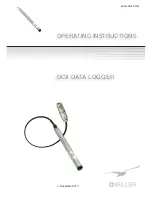
Hydro Logger H40
User manual
8
electronics for ecology
FIEDLER
2.1.
Overview of program procedures and functions
The following overview briefly summarizes the programming procedures and functions
contained in the H40 station FW, which are fully available to the station users during its
parameterization and setup. Most of these functions will be described in detail in the
"Setup" chapter.
▪
Calculation and storage of the measured quantity in set units of measurement
▪
Non-linear signals can be corrected by a 2nd order polynomial separately for
each of the set channels.
▪
Calculation of the remaining capacity of the power battery based on continuous
measurement of the current drawn from the battery
▪
Separate limit alarm for each recording channel
▪
Separate gradient alarm for each recording channel
▪
For the duration of an alarm on a channel, you can set a different frequency of
data being written to memory and a different frequency of data being sent to the
server than in the normal state.
▪
Data transmissions are performed under the FINET protocol (binary protocol
with fixed frame) or Modbus RTU. Data packet transmissions over the
GSM/GPRS network are performed under the TCP/IP protocol.
▪
Regular sending of archived values via GPRS network to the Internet to the set
IP address (to the server with the MOSTNET-SERVER program installed)
▪
Phonebook for 10 recipients, up to 3 groups possible
▪
Alert system based on 14 user configurable SMS messages
▪
Activation of sending SMS or transferring data to the server via GPRS network
periodically in time or after reaching the limit value on the measuring channel,
after activation of limit or gradient alarm, in case of sensor fault, low battery volt-
age, after activation of binary input or on request by SMS
▪
Adjustable delay and hysteresis for SMS warning limits
▪
25 query and command codes for creating a query or control SMS
▪
Automatic insertion of the instantaneous value of the measuring channel into the
SMS text
▪
Setting the time for sending daily SMS and the day for weekly SMS
▪
Automatic switching between daylight saving time and standard time, automatic
time comparison with the server
▪
Automatic archiving of the current parameter file on the server after each pa-
rameter change
▪
The event log contained in the data memory records extraordinary events (acti-
vation of selected inputs, incoming and outgoing SMS, occurrence of error sig-
nals at connected sensors, successful and unsuccessful data transmission to
the server, etc.).
C o m m u n i c a t i o n
O p e r a t i o n a l
d i a r y









































